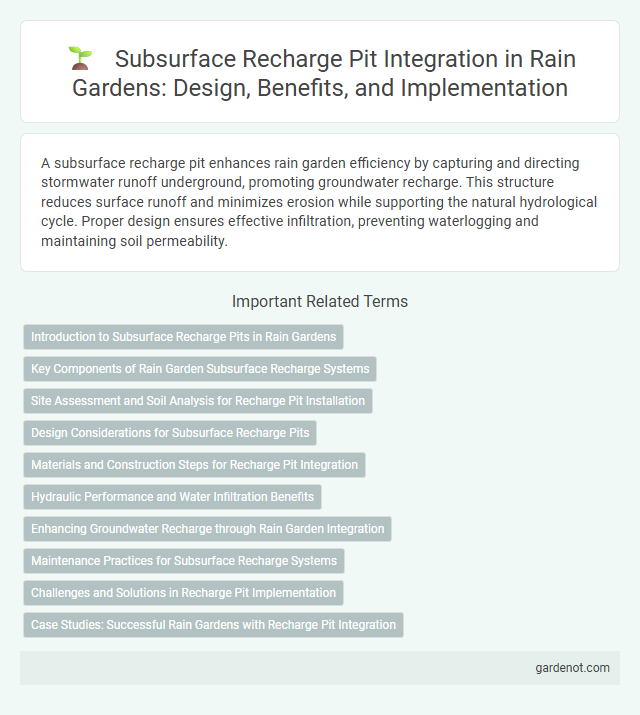A subsurface recharge pit enhances rain garden efficiency by capturing and directing stormwater runoff underground, promoting groundwater recharge. This structure reduces surface runoff and minimizes erosion while supporting the natural hydrological cycle. Proper design ensures effective infiltration, preventing waterlogging and maintaining soil permeability.
Introduction to Subsurface Recharge Pits in Rain Gardens
Subsurface recharge pits in rain gardens facilitate stormwater infiltration by directing runoff into underground voids filled with permeable materials like gravel, promoting groundwater recharge. These pits reduce surface runoff volume and peak flow rates, mitigating urban flooding and improving water quality by filtering pollutants through soil layers. Proper design of subsurface recharge pits considers soil permeability, pit size, and connection to rain garden inlets to optimize hydrologic function and ecosystem benefits.
Key Components of Rain Garden Subsurface Recharge Systems
Subsurface recharge pits in rain garden systems consist of key components such as a perforated distribution pipe, aggregate fill, and an infiltration chamber designed to promote efficient stormwater infiltration. A geotextile filter fabric envelops the pit, preventing sediment clogging while allowing water to percolate into the surrounding soil. These components work together to enhance groundwater recharge, reduce surface runoff, and improve urban water quality.
Site Assessment and Soil Analysis for Recharge Pit Installation
Site assessment for subsurface recharge pits involves evaluating topography, drainage patterns, and proximity to utilities to ensure optimal water infiltration and avoid structural impacts. Soil analysis prioritizes permeability tests and texture classification, identifying sandy or loamy soils that facilitate efficient stormwater recharge. Proper assessment prevents clogging and maximizes groundwater replenishment by aligning recharge pit design with soil infiltration rates and site conditions.
Design Considerations for Subsurface Recharge Pits
Subsurface recharge pits require careful consideration of soil permeability, depth, and dimension to ensure effective stormwater infiltration while preventing groundwater contamination. Designing with layers of gravel and filter fabric enhances infiltration rates and prevents sediment clogging, promoting long-term pit functionality. Proper setback distances from foundations and utilities are critical to avoid structural damage and maintain water quality control.
Materials and Construction Steps for Recharge Pit Integration
Subsurface recharge pits are constructed using permeable materials such as coarse gravel, crushed stone, and geotextile fabrics to enhance water infiltration and prevent soil clogging. The construction process involves excavating a pit below the runoff source, lining it with geotextile to separate soil and aggregate, backfilling with graded gravel, and installing an inlet pipe to direct stormwater into the pit. Proper layering ensures efficient subsurface recharge, promoting groundwater replenishment and reducing surface runoff in rain garden systems.
Hydraulic Performance and Water Infiltration Benefits
Subsurface recharge pits enhance hydraulic performance by allowing rapid infiltration of stormwater into the groundwater, reducing surface runoff and mitigating flood risks. These structures increase water infiltration rates through engineered void spaces and permeable layers, improving soil moisture retention and groundwater recharge efficiency. Optimized subsurface recharge pits support sustainable stormwater management by maintaining natural hydrological cycles and promoting long-term water quality benefits.
Enhancing Groundwater Recharge through Rain Garden Integration
A subsurface recharge pit within a rain garden effectively captures and directs stormwater runoff to permeable layers, promoting efficient infiltration and replenishment of groundwater aquifers. Engineered with layers of gravel and sand, these pits enhance soil permeability and prevent surface runoff, reducing urban flooding and improving water quality by filtering contaminants. Integrating subsurface recharge pits in rain garden designs accelerates natural groundwater recharge cycles, supporting sustainable water management in urban landscapes.
Maintenance Practices for Subsurface Recharge Systems
Regular inspection and removal of accumulated debris in subsurface recharge pits ensure optimal infiltration rates and prevent clogging. Routine maintenance includes checking inlet and outlet structures for blockages and repairing any damaged liners or gravel layers to maintain system integrity. Implementing scheduled sediment removal and vegetation management enhances long-term functionality and supports effective stormwater recharge.
Challenges and Solutions in Recharge Pit Implementation
Recharge pit implementation faces challenges such as soil permeability variability, clogging from sediment accumulation, and groundwater contamination risks. Solutions include conducting detailed geotechnical assessments, installing sediment traps or filter media, and designing overflow structures to manage excess water while protecting water quality. Regular maintenance schedules and monitoring systems are essential to ensure long-term functionality and prevent reduced infiltration capacity.
Case Studies: Successful Rain Gardens with Recharge Pit Integration
Case studies of rain gardens featuring subsurface recharge pits demonstrate significant improvements in stormwater management and groundwater replenishment. Projects in urban areas like Seattle and Portland have successfully reduced surface runoff while enhancing infiltration rates by integrating engineered recharge pits beneath rain gardens. These installations also mitigate flooding risks and improve water quality, showcasing effective sustainable landscape solutions.
Subsurface recharge pit Infographic

 gardenot.com
gardenot.com